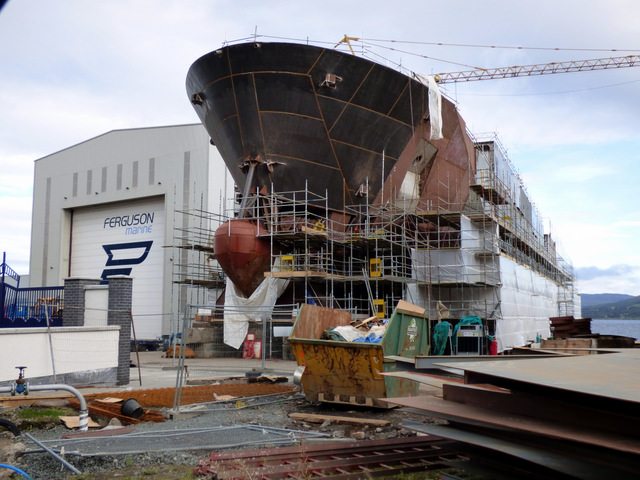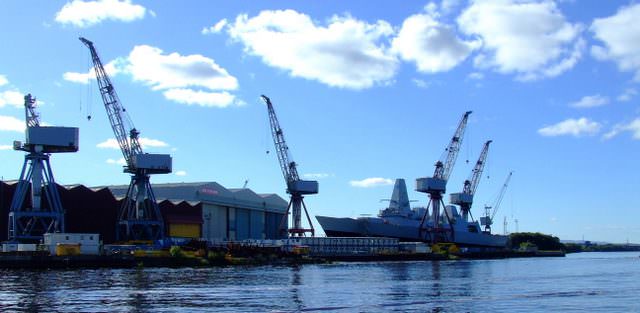Scotland has a very proud tradition in shipbuilding. Historically, shipyards operated in every town linked with the ocean; Dumbarton, Inverclyde, Glasgow and Ayrshire, Dundee, Leith, Aberdeen are some of the more notable ones. Construction projects varied from fishing and naval fleets to ferries and cruise ships, for customers all-around the globe. However, Scotland’s shipbuilding industry is now a shadow of its glorious past. Ferguson Marine Engineering Ltd is the last commercial shipbuilder on the Clyde and BAE Systems’ warship construction constitute the only shipbuilding activity remaining in Scotland.
A question that has been frequently asked, since the 2014 independence referendum, is whether BAE and the UK’s Ministry of Defence (MoD) would continue their shipbuilding activities in an independent Scotland? We believe that the possibility of not having UK’s MoD contracts for the construction of naval fleets in Scotland should be seen as an opportunity rather than presented as a catastrophe. In the same sense, it should not be seen as a reason to reject independence.
To clarify, those posing the above question are usually worried that an independent Scotland would not be able to continue the construction of naval vessels and thus the few thousand jobs it supports would be lost. In the face of this threat, they end up believing that remaining in the UK is a better option or at least a safer one. Now, it would be fair to say, that the shipbuilding activities on behalf of the UK’s MoD would most probably stop in an independent Scotland. This is based on the fact that the UK’s MoD has never had any of its warships built by another country.
However, it must be emphasised that the main reason Scotland’s shipbuilding activities have regressed, to almost being non-existent, is the privatisation policies adopted by successive UK government’s since the 1960s. This is more apparent in Glasgow, the city in which the industry was so dominant at the beginning of the 20th century that it was literally everywhere.1 Glasgow’s shipyards were employing half the British shipbuilding workforce by the end of the 19th century while producing half the tonnage of Britain’s shipping.2
Since the late 1960s though the landscape of the UK’s maritime sector and of shipbuilding in particular changed mostly due to the UK governments’ attempt to privatise the maritime sector. This approach signified the gradual withdrawal of the UK government from the sector through transferring the control of the majority of UK ports to private equity funds, such as the Peel Ports Group, the Associated British Ports Holdings Ltd, and the Aggregate Industries Group among others. The UK governments, since 1979, have essentially diminished their power over maritime policy and their ability to determine, to a large extent, the future of the sector.3
It is at least a paradox then to argue that Scotland should stay in the UK in order to safeguard its shipbuilding industry. This paradox is reinforced by the UK MoD’s intention to built fleet solid support ships in the Far East to save money.4 These support ships are currently being built in Scotland, basically keeping the Rosyth’s shipyard operational. In other words, it is not only that successive Conservative and Labour governments turned Scotland’s shipbuilding industry into a shadow of itself. It is also that remaining in the UK does not even provide a reassurance that Scotland’s shipbuilding activity will continue.
Does this mean that shipbuilding activity in Scotland is destined to end? On the contrary, it seems that it has the opportunity to change and, much like every other socio-economic activity, follow the urgent need for sustainable alternatives. In this case, sustainable shipbuilding is a viable alternative with the potential for profit that makes it attractive to private investors. For instance, wind-propulsion technologies have the potential to offer to shipping companies double-digit savings on fuel consumption.5
 Sustainable shipbuilding can be simply defined as a cost-effective commercial activity, in which the environmental load is not larger than that which the environment can bear.6 Focusing on sustainable shipbuilding is already happening in many shipyards in the Netherlands.7 Reactivating Glasgow’s two derelict and mothballed dry docks in Govan and in Inchgreen could be the way to initiate sustainable shipbuilding activities in Scotland. More information about sustainable shipbuilding and our full proposals is available in one of our forthcoming reports that deals with maritime policy in Scotland.
Sustainable shipbuilding can be simply defined as a cost-effective commercial activity, in which the environmental load is not larger than that which the environment can bear.6 Focusing on sustainable shipbuilding is already happening in many shipyards in the Netherlands.7 Reactivating Glasgow’s two derelict and mothballed dry docks in Govan and in Inchgreen could be the way to initiate sustainable shipbuilding activities in Scotland. More information about sustainable shipbuilding and our full proposals is available in one of our forthcoming reports that deals with maritime policy in Scotland.
Meanwhile, an alternative or complementary proposal that would solve the job-losses problem, a potential end to naval shipbuilding activities in Scotland would bring forth, is the production of electricity through utilising Scotland’s wave and tidal resources. Wave and tidal stream energy is electricity generated from the movement of wave and tidal flows, which are more predictable than wind power.
According to a report commissioned by the Scottish government a tidal barrier at the mouth of the River Clyde, located between Greenock and the Ardmore Point, would generate multi-benefits including renewable energy generation and improving flood defences. The estimated generation capacity of approximately 200GWH per year would be enough to power every home in Glasgow.8 Most importantly, Scotland already has the personnel with the expertise to make this happen.
The main skills requirements expected for these jobs are similar to the ones possessed by engineers, project managers, turbine technicians, divers, and managers currently working at BAE’s Scottish shipyards. Meanwhile, the Scottish government in 2011 estimated that wave and tidal power could provide 5,300 new jobs by 2020.9 According to the Fraser of Allander institute, the two yards in Glasgow support a total of 5,943 jobs.10
To sum up, back in the day, when Glasgow was a global nautical power, it was the turn from sail to steam that played the most important role.11 It now looks like that through sustainable shipping, such as the initiative by Ferguson Marine to build the world’s first renewables-powered hydrogen ferry in Port Glasgow,12 the term “Clydebuilt” can become again a byword for quality, precision and innovation.
References
- Bellamy M. (2006), Shipbuilding and Cultural Identity on Clydeside, Journal of Maritime Research 8:1, pp. 1-33, p. 8.
- Fraser W. H. (2004), Second City of the Empire: 1830s to 1914.
- Monios J. (2017), ‘Port Governance in the UK: Planning without Policy,’ Research in Transportation Business and Management 22, pp. 78-88, p. 83.
- Rosyth Shipbuilding set to suffer from huge MoD funding gap.
- Lloyd’s Register report as cited in Interreg IVB SAIL (2015), Roadmap for Sail Transport, p. 7.
- Cabezas-Basurko et al, 2008 as cited in Kotrikla A.M. (2017), ‘Green versus sustainable: The Case of Shipping,’ paper presented in the 15th International Conference on Environmental Science and Technology, p. 3.
- World Maritime News, In Depth: Dutch Shipyards Are Looking to the Future.
- Clydeplan (2016), Strategic Development Plan: Low and Zero Carbon Generating Technologies.
- Campaign Against Arms Trade (2015), Arms Industry in the Clyde & Renewable Energy Options.
- Fraser of Allander Institute (2016), The Defence Industry in Scotland.
- Smith R.M. (1921), The History of Greenock, (Greenock: Orr Pollock & Co), pp. 91-92.
- University of St. Andrews News (2018), Ferguson Marine to develop renewables-powered hydrogen ferry – HySeas III.








Small independent maritime nations such as Norway, Denmark, Ireland and even Iceland, each have a navy, which consists of, at minimum, Patrol, Fisheries , and Coastguard vessels.
It would be remiss of a Scottish government not to have such a capability. If part of NATO it would be expected.
So, where would these vessels be built? Ireland had to go to England for their recent 4 ships. There is knowledge and expertise in Scotland.
Then there is the question of the servicing and maintenance of the vessels which would mean jobs at exiting or new facilities. In addition, other nations could well be in the market for Scottish built ships.
However, if the yards are controlled by multinational firms, then there is always the possibility that they will be closed as and when the companies see fit. With government initiatives the Scottish industry could perhaps rival that of Norway which in 2018 had orders totalling over £1.5 billion.
Norway employs around 10,000 in shipbuilding.
Norway built its frigates in Spain; Denmark built its frigates in Poland and then towed them home to be fitted out. Scottish shipyards have a sad history of late delivery, high costs, poor labour relations and mediocre workmanship (see Fergusons or delays on the carriers). The BAE Systems yards in Glasgow have a 600% higher wastage rate than the Cammell Laird yard in Birkenhead. They are too small, old fashioned and unsuitable for low cost production. They should have been closed in the 1970s and a new warship yard constructed on one of the sea lochs up the west coast, complete with a new town to support it. The design skills to build complex warships are in England (and it is a lot more difficult than you might think – I speak from experience). Does that suggest there is a ready market from Scots ships after independence? If Scotland leaves the Uk the yards will close as soon as the last orders are complete.
An independent Scotland would be entitled to approx 10% of UK assets, which includes all defence….. Ships, aircraft, heavy artillery etc, etc, etc.
Doesn’t work like that bud
BAE Clyde is a commercial shipbuilder, just focused on naval contracts. They are not state owned.